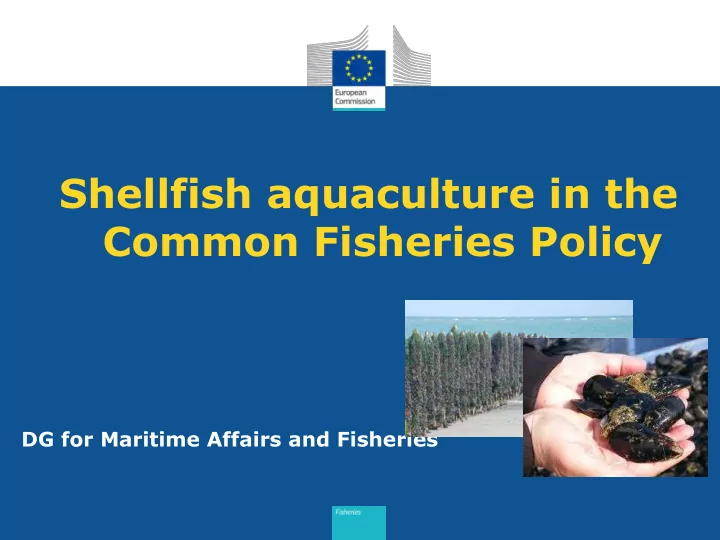

Shellfish aquaculture in the Common Fisheries Policy DG for Maritime Affairs and Fisheries
Aquaculture in the EU • 1.3 million tonnes production • Worth 3.6 billion € • 80.000 direct jobs • Many different species and production systems
EU aquaculture production by type (volume) Freshwater Marine finfish 22% 28% Shellfish 50%
The EU shellfish sector in figures • 0.68 million tonnes • 1.12 billion € • 55-65,000 jobs • Main species: • Mussel (492k t, 429k € ) • Oyster (99k t, 438k € ) • Clam (37k t, 172k € ) • Main producers: Spain, France, Italy
Filling the gap EU seafood consumption EU Captures 25% Net imports 65% EU Aquaculture 10%
Blue growth: job creation in coastal and inland areas • Blue Growth Communication 2012 (COM(2012)494 13,9,2012 • Five main focus areas: Aquaculture; Renewable energy, biotechnology; coastal & marine tourism and mineral resources • Action Plan for a Maritime Strategy in the Atlantic Area
Blue growth • With current labour productivity, every 1% of our seafood consumption produced by EU aquaculture could help creating 3-4.000 full- time jobs • Mostly in coastal and rural areas, important local impact • Shellfish: labour intensive, high job creation potential
Aquaculture in the CFP • "Basic Regulation": open method of coordination • "Common Market Organisation" Regulation: labelling, producers organisations • European Maritime and Fisheries Fund (EMFF) • Aquaculture Advisory Council • Aquaculture research: Horizon2020
The Open Method of Coordination • "Soft" approach – no change in EU legislation • Union strategic guidelines: common priorities and targets • Multiannual national strategic plans • Exchange of information and best practices
Union Strategic Guidelines COM(2013)229 1. Reduce administrative burdens 2. Facilitate access to water and space 3. Improve competitiveness 4. Exploit competitive advantages – "level playing field"
2. Facilitate access to space and water • "Lack of space" or "No access to space"? • Use of spatial planning to identify best location and make aquaculture development: • More sustainable • More socially acceptable • Less uncertain (and more interesting for investors) • Maritime Spatial Planning Directive
3. Increase competitiveness • Promote R&D, innovation, business differentiation • Exploit business opportunities (e.g. integration with angling and tourism, offshore wind farms) • Valorise environmental services (e.g. extensive ponds and habitat conservation) • Stronger producers organisations
4. Exploit competitive advantages – "Level playing field" • EU aquaculture offers high standards of: • Environmental protection • Health • Consumer protection • Inform consumers (food labels, information campaigns) • Exploit niche markets (certification schemes, organic aquaculture)
Multiannual national plans • Based on Strategic Guidelines and specific conditions in the Member States • Define Member States' objectives and the measures to achieve them • Cover the period 2014-2020 • Consistent with EMFF planning
Increasing competitiveness • Art. 47 (innovation) : new processes, products, species • Art. 48 (productive investment) • Art. 49 (advisory services) : provision of advisory services to farmers, covering: - environmental legislation - impact assessment - animal health and welfare - public health - health & safety - marketing and business strategies • Art. 50 (human capital) : - Professional training, lifelong learning - Improved working conditions - Networking
Support for aquaculture research under Horizon2020 "Societal Challenges" number 2: Food security, sustainable agriculture and forestry, marine and maritime and inland water research, and the bioeconomy Budget of € 3.8 Billion for the period 2014-2020 (twice the FP7 budget for the same thematic area in 2007-2013) Innovative, Sustainable Sustainable Blue Growth Food Security and Inclusive Bioeconomy
Examples of relevant calls 2014- 2015 Food security Tackling disease-related challenges and threats faced by European farmed aquatic animals Indicative budget: € 7 million for 2014 (fish parasites), € 4 million for 2015 (mollusc diseases) Sustainable food production systems Implementation of an Ecosystem-based approach for European aquaculture Indicative budget: € 3 million for 2014 (spatial planning), € 7,5 million for 2015 (aquaculture/environment)
Knowledge Gate • www.kg.eurocean.org
Thank you for your attention!
Recommend
More recommend